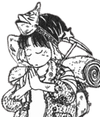Talking games - Mad Panic Coaster
On the stupid joys of anxiety.

The world was once full of papurin.
First appearing in Kojima Yoshinori’s Weekly Shounen Jump gag manga Toudai Icchokusen—about a fool mistakenly believing himself a genius—papurin is a portmanteau for “your brain is like pudding”, a jokey insult and catchy punchline that makes the speaker seem just as ridiculous; a lighthearted jab towards friends and acceptance of stupidity. And for a time it was all the rage. Major comedians dropped the word in their act, multiple TV shows included it in their titles, and other manga used papurin too, giving characters a youthful energy. It was everywhere…until it wasn’t. Like all words, papurin grew old and died a slow death of fading relevance, only dug up now as a retro throwback or nerdy reference.
Mad Panic Coaster is papurin. The arcade-style roller coaster thrill ride, published in 1997 by Japanese ad agency Hakuhodo for the Playstation, is deliriously dumb in the smartest ways; a stunning landmark in adrenaline and digital speed, a sustained “oh my god” stuffed into the throat. Pushing away from realism and fully embracing its own rebelliously silly aesthetic, it captures the thrills and stupid fun of a roller coaster better than anything else I’ve ever seen.
Not that I’m an expert. I’ve only ever ridden a roller coaster once: Space Mountain in Disney Land, on a high school band trip. I don’t remember much about it anymore, but I know that after the initial rush had settled and I could breath again in that dark maze of hanging rails and support beams flying by, I had a thought: if I raised my hands high enough, would they hit metal? Would they cut cleanly off?
I do that a lot, imagine the horrible dangers of fun. I’m a mess of anxieties and neuroses, the natural enemy of the amusement park. I spent my childhood both entranced by them and too terrified to ever go—what if things went wrong, what if something breaks, what if gravity doesn’t do its job? I'd see a carnival ride and think about them running wild: a ferris wheel rolling away, a spinning jet disconnecting and flying off into a building.

Luckily, the protagonists of Mad Panic Coaster are not me. Students at Papurin Elementary School, Batayan and Kyako (combining the name Kyoko with a shrill scream) delight in manufactured danger, always on the hunt for bigger thrills and faster speeds. When suddenly whisked away to Madland by the crazed and disfigured Professor Jones—burned by a stray firework in a sad obsession with making the world’s greatest roller coaster in order to please an uncaring son—the two are forced to endure his absurd creations, greeting their potential death with both fear and excitement.
And what roller coasters they are. Massive structures in dungeons, mountains, and mushroom forests throw you down vertical drops and push up against the limits of human reaction with sudden sharp turns, quick obstacles, and jumps out of nowhere. Every inch of these constructions is intent on taking chunks out of an already small health bar. Split second decisions reign supreme here: surviving each roller coaster’s three laps predicated on movements made before one can even think.
Mad Panic Coaster truly lives up to its name: a chaotic rush of some of the fastest speeds in video games, an assault of joy, panic, and excitement only knowable when riding a coaster.
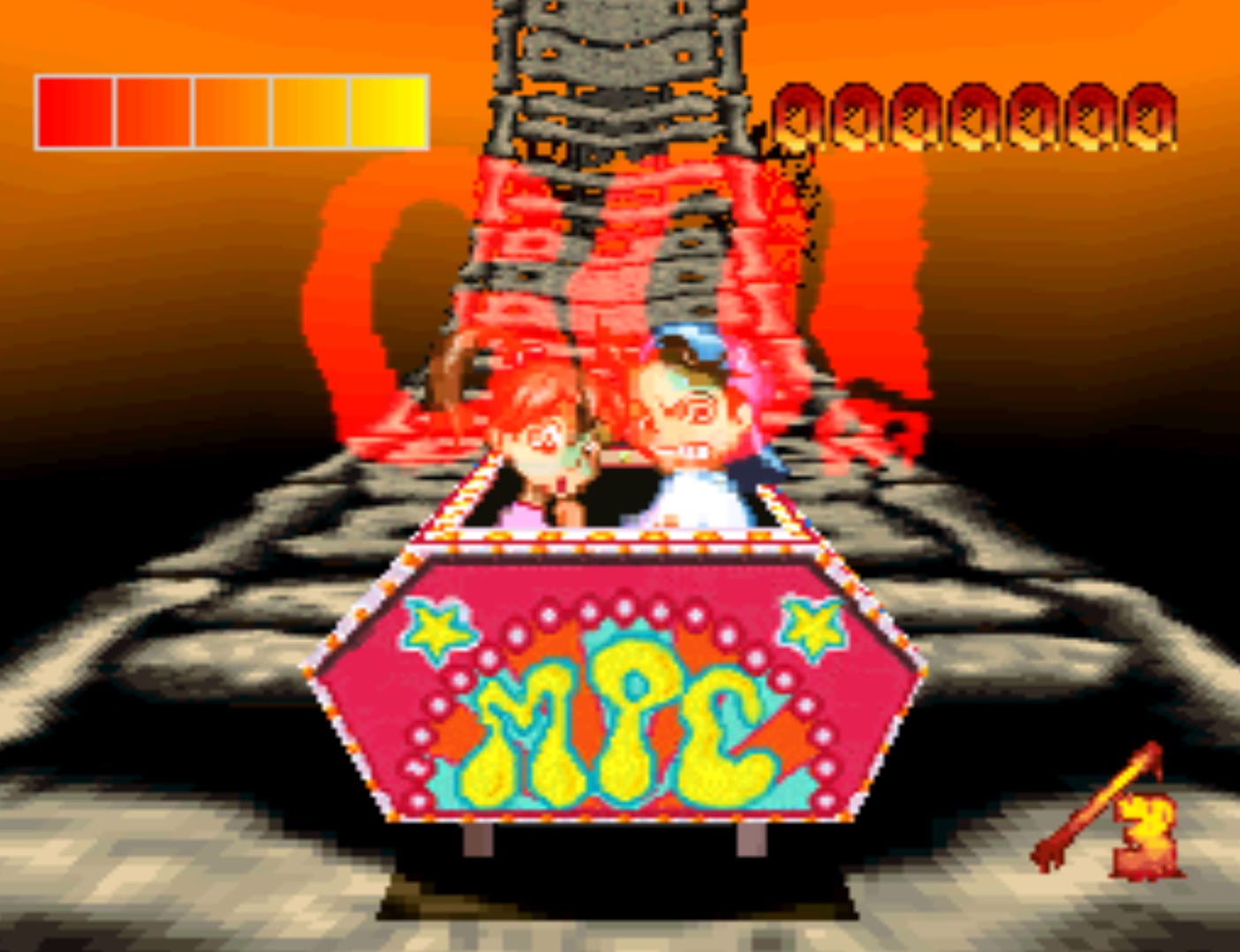
While simply surviving the tracks themselves is the main focus, they aren’t the only worry, as monsters and enemies litter every stage. Some are little more than distraction—creatures to pull ones focus away from the ride, or bump up for a cheap hit—while others are more proactive, hurling attacks and bouncing around in front of the cart as if to mock you. Thankfully, you aren’t completely defenseless. Balls can be thrown to three different distances (close, mid, and far each assigned to a different face button) in order to knock the enemies off and find some breathing room. This is much easier said than done however, the chaos of the game already so overwhelming that each stage frequently devolves a blind panic, wildly lobbing balls wherever you can and hoping for the best.
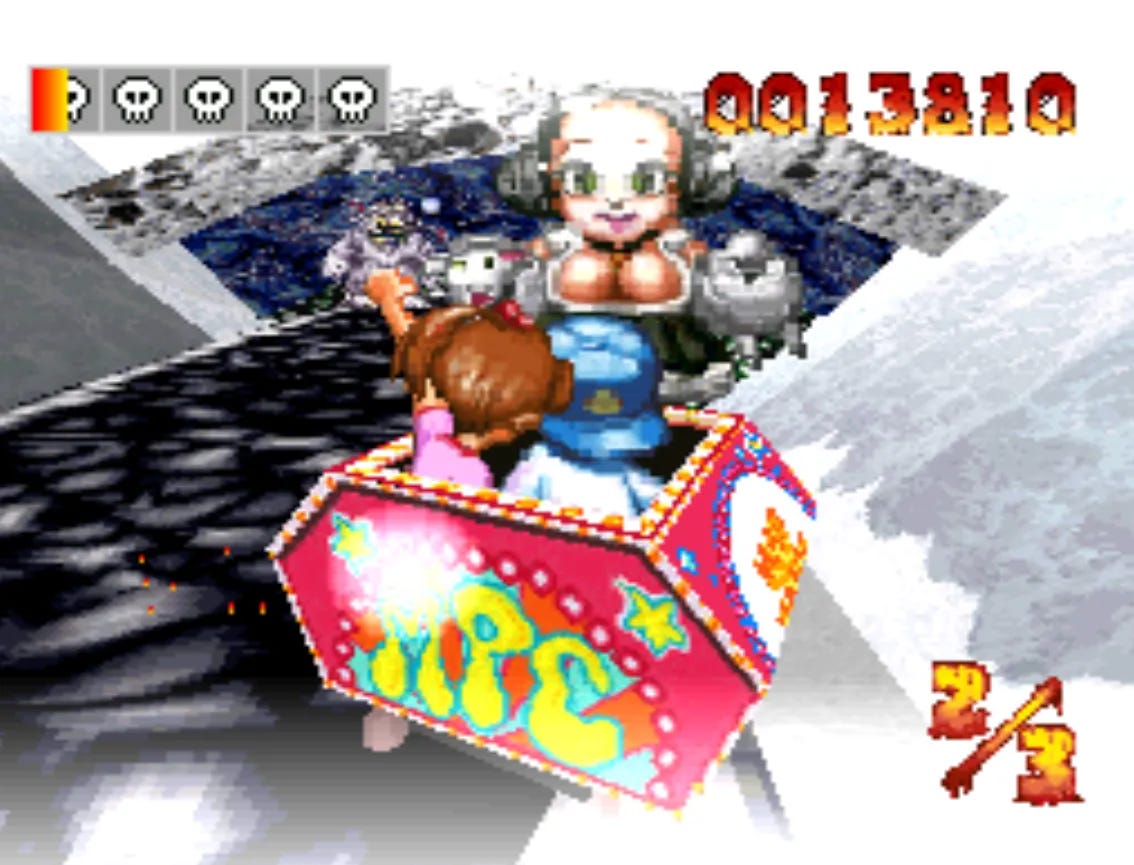
At least until you reach one of the bosses, who arrive every third stage and force you to prove your skills in one of two ways: either defeat them, or survive the track for a grueling six laps instead of the usual three. With the usual chaos pared back to focus on a single enemy, these skill checks act as a perfect chance to hone your focus and attention, to adapt to the world of speed. Just like when I rode my single roller coaster, eventually the body and mind adapts; thoughts return, if only a little, as the player hits a zen-like state, deftly avoiding debris and destroying enemies while the cart screeches on the edge of the track.
These bosses, and all of the enemies, are an absolute treat to witness, even if they move by so quickly you can only ever hope for vague impressions. Rendered into large cartoony sprites, zombies, eyeballs, melted people and mutated things zoom by in a blink, wonderful focal points in a world already bursting with color. Detailed, imaginative 3D backgrounds constantly change with each track, pop art sensibilities crashing into video game landscapes, creating a genuine excitement for what might be next.


This style is also largely responsible for the game’s sense of speed—what should be a clashing blend of 2D and 3D instead creates an impressive sense of movement perhaps best exemplified by the track itself, with flashes of black and color between its multitude of thin boards selling just how fast everything is. The game, then, is wholly devoted to its aesthetic down to the most fundamental level, presentation made inexorable from gameplay, experience tied deeply to what the player sees and how.
And this look, full of grotesqueries and silliness, is one already intimately familiar to many, calling forth memories, associations, and feelings, one with its own history that only enhances the games tone. It’s punk.
It makes perfect sense. There is no music more papurin, more suited for thrills, absurdity, and youthful, anxious destruction than punk, and Mad Panic Coaster is full of it.
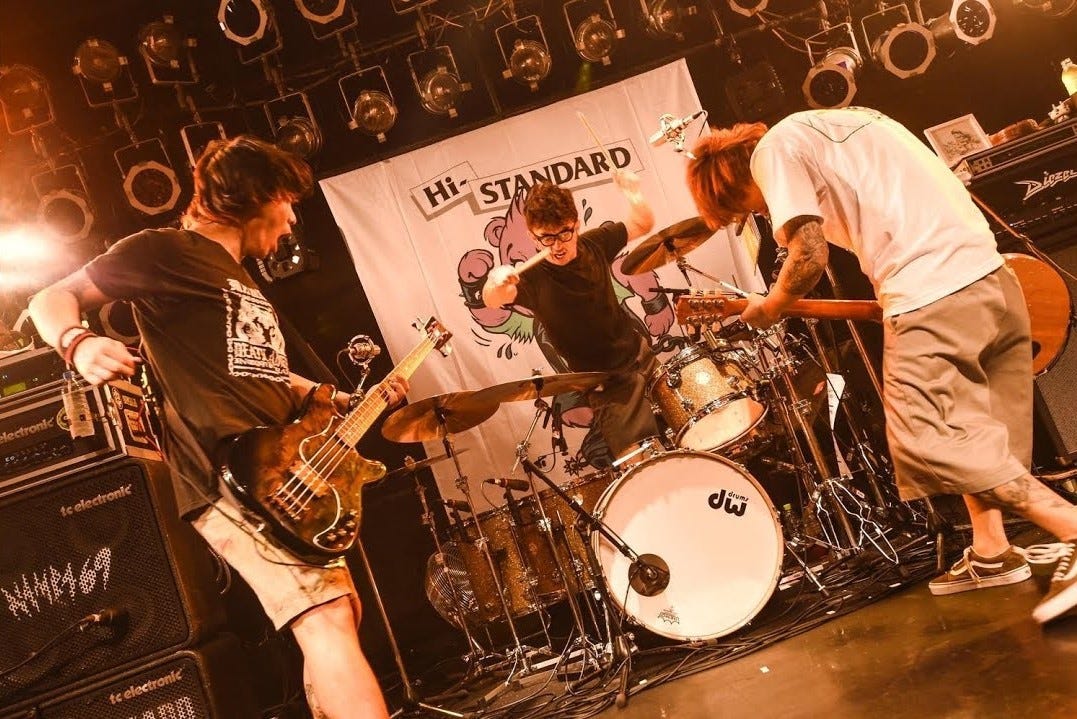
Few punk bands that have broken into the Japanese mainstream quite like Hi-STANDARD, and those who have are probably indebted to them. Formed as the 90s began, the melodic hardcore band quickly gained massive success—albums selling in the hundreds of thousands, stadium shows regularly sold out, and consistent tours playing with some of the genre’s most popular acts of the day, including Green Day, Rancid, and NOFX—and it’s easy to hear why: their songs are loud, rip-roaring explosions of energy, but also deeply melodic, filled with ear-worm after ear-worm and hooks dripping with nostalgic, youthful rebellion. Among the members, singer and guitarist Ken Yokoyama would emerge as a leading face of mainstream punk in Japan, releasing several solo albums, forming the similarly successful BBQ Chickens, and founding the PIZZA OF DEATH RECORDS label all in the span of a decade, proving himself to be one of the busiest musicians of the time. And at the height of the band’s popularity, he took on another project, one that has largely gone unnoticed despite its pedigree: he made the soundtrack for Mad Panic Coaster.
Every level of the game naturally begins with the ascent. It’s essential to the success of a roller coaster, a machine at least half reliant on the art of anticipation. As you climb, view obscured by the rising track, a guitar strums a crunching staccato beat: Chunk. Chunk. Chunk. Chunk. When you hit the precipice, Kyako lives up to her name and lets out a piercing scream. The cart plummets, the music explodes, and all hell breaks loose. Blasting drums and bright guitars in major keys play catchy, sunshiny riffs that drip with reggae, ska, and surf rock influences fly at tempos to match the cart—papurin tunes for getting hurt to. Carrying the energy of Hi-STANDARD into the game, the soundtrack rounds out the tone, turning Mad Panic Coaster into a complete aesthetic experience, every inch working in perfect harmony.
Thank god the music is so good too, because you will hear these songs a lot. Mad Panic Coaster is difficult. After only a few stages the game ramps up to near uncontrollable levels; the speed gets faster, the enemies and obstacles more constant, more dangerous, turns on turns in the blink of an eye and gimmick levels with tracks made slippery, the cart perpetually ready to crash. You will fall off the tracks, and you will fall off a lot. You will hit things and be hit by others, taunted by Dr. Jones, greeting by Game Over again and again, Batayan and Kyako trapped in a purgatory of pain.
I haven’t been on a roller coaster since that first time. I haven’t been on any ride. I don’t think about horrors of amusement parks much anymore, but my worries still remain. Only their focus has changed, head now filled with car crashes and images of steel pipes in the back of trucks running through my windshield.
Maybe that’s why I love Mad Panic Coaster. In a few moments Batayan and Kyako will return from death, covered in scratches and bruises and ready to do it all over again, reveling in the violence my anxieties. And why wouldn’t they? They go to Papurin Elementary, after all. They live for the thrill. They live to be dumb.
I hope I can, too.
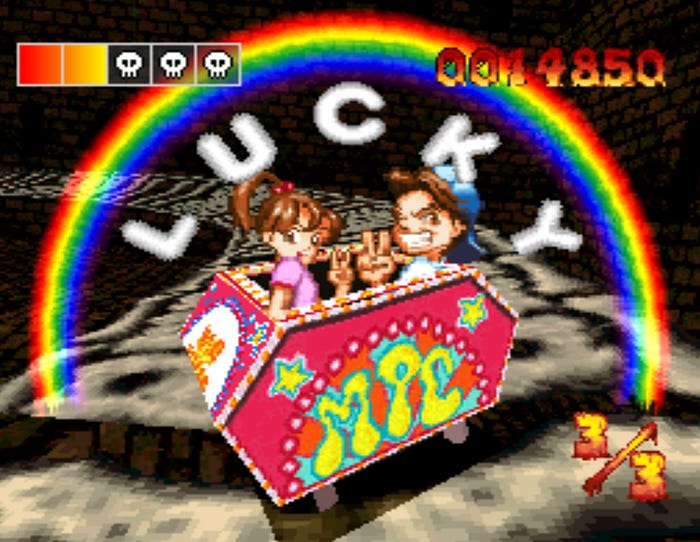
Music of the Week: AIR-CON BOOM BOOM ONESAN - E.P
A young comedian takes a total zag, releasing three music tracks out of nowhere with two versions each: first as blistering no-wave scorchers, then reinterpreted as synthy new wave bops. I know, it sounds like a complete gimmick that should by all accounts be out-of-touch, but Onesan got the bona fides—this is real deal stuff, with some serious names attached in the back. The no-wave half especially kind of knocked me off my feet as some of my favorite rock from Japan this year!
Book of the Week: Kimagure Robot by Shinichi Hoshi
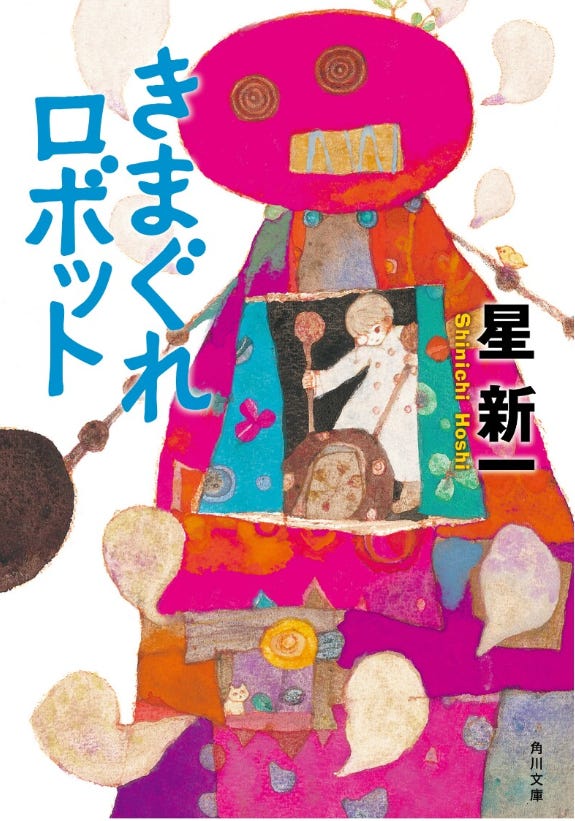
Also known as The Whimsical Robot / The Capricious Robot, this collection of three to four paged stories from Japan’s undisputed king of the “short short” (“flash fiction” in English) is an overflowing toy-box of delights. Time after time, Hoshi crafts these charming little sci-fi slices of imagination that play out with the rhythm of a perfect joke: set-up, build and punchline hitting home-runs left and right. These are stories that any child will get lost in, the endless possibility and creativity on display completely absorbing them, and stories that will turn any adult reading right back into those enraptured kids. If you want fun, playful sci-fi then truly nothing in the world can reach the heights of Hoshi.1
Movie of the Week: Alien Artist




Alien Artist is true punk filmmaking, using its micro-budget to create a deeply ambitious and weird slab of psychedelic dystopian hip-hop sci-fi all about a cult-like rapper who takes control of a town and the spy games behind played out to try and stop him. Until it suddenly isn’t about that at all, of course, and decides it’s actually about a group of kids who live in a lawless school. I’m not sure anybody really understands exactly what is going on here, but I am sure that by the time its saturated, surreal thriller and its stark, black and white adolescent nightmare converge in a medium-hopping apocalyptic explosion, that sense and logic couldn’t possibly matter less.
Thanks for visiting! If you liked what you read, share it around! It’d make my day :)
oh, and here’s the incredible history of the very first eroge ever made.
Hoshi literally means star this is a pun please laugh ↩

